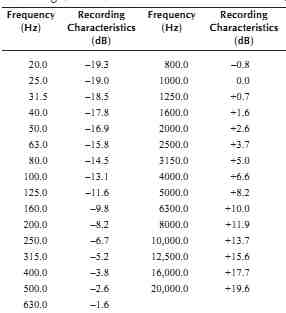To overcome the limitations found in the basic disc-cut ting and reproducing process, special equalization of the signals before and after the recording was developed.
When all signals that appear in the program bus are analyzed, we can see that the amplitude is the highest at low frequencies and the lowest at high frequencies. The relationship between the frequency of the signal and its amplitude where amplitude is inversely proportional to frequency is called a constant velocity characteristic, FIG. 1.
If the signals are recorded without equalization as they arrive, the low-frequency excursions would take all the space. The high frequencies would be of such a low amplitude that during the playback, high-frequency signals could be very close to the noise level of the system. The SNR then would be extremely small. This problem was recognized in the early days of disc recording, but the remedy used was only partial. At first only the low end of the audio spectrum was equalized.
The cutting head sensitivity was decreased at low frequencies so that the amplitudes in midrange and at high frequencies could be recorded at higher levels.
Then, the playback amplifiers were adjusted to boost the low frequencies to compensate for the losses introduced in recording. From this point on, the equalization used for cutting was called preemphasis, and equalization used in playback equipment, post-emphasis.
The 1 kHz signal was chosen as the reference point because it was a convenient halfway point between the low and high frequencies. As time went by and further improvements were made, the equalization was extended to the higher frequencies as well. What emerged from the long and at times controversial subject of equalization are the RIAA and NAB equalization curves. The first curve was used by the Record Industry Association of America (RIAA) and the second, which is almost identical to the first curve, by the National Association of Broadcasters (NAB).
People still debate about two versions of the recording equalization. The DIN (Deutsche Industrie Norm) standard used in European countries calls for additional equalization at the extreme low end during playback to improve the SNR and stability of the system due to mechanical disturbances--i.e., turntable rumble-which can affect the overall performance of the system.
The NAB (RIAA) curve used presently in the play back equipment is shown in FIG. 2. The numerical values for the characteristic are shown in Table 1.
For recording, the inverse curve is used. It means that if the playback signal is boosted +19.3 dB, the same signal should be recorded at the level of -19.3 dB so that the overall result will be 0 dB deviation from the ideal flat response curve.

FIG. 2. NAB (RIAA) standard reproducing characteristic.
Equalization is used to record the sound at the most advantageous levels for the best results as far as distortion and noise are concerned and to reproduce it so that the original balance between the frequencies can be restored. The RIAA curve is used for phonograph discs.
Tape recorders record signals on tape, and tape recording has limitations that differ from the limitations found in mechanical recording and, therefore, require different pre-emphasis and post-emphasis for best results.

Table 1. Preferred Frequencies and Calculated Recording Characteristics
The RIAA curve covers the range from 20 Hz-20 kHz. The DIN curve, as shown in FIG. 3, extends the control over playback down to 2 Hz where the equalization returns back to 0 dB. As can be seen from the graphs, the curves have complex shapes; equalizer circuits use capacitors and resistors, and their values determine the amount of signal equalization that can be expressed as a function of a time constant in microseconds as derived from the equation
T=CR (1)
where,
T is a time constant, C is capacitance in farads, R is the total effective resistance of the supply network in ohms.
This is part of the equation to determine the attenuation at various frequencies:
attenuation dB= 10log ( 1 + ω2T2) (2)
where, ω_is 2πf,
T is CR of Eq. 1.
The RIAA curve consists of three time constants; 75 µs to roll off the high frequencies, 318 µs to produce the slope below 1 kHz with a knee at 500 Hz, and a 3180 µs time constant to flatten the low end of the curve. In today's modern amplifiers, the equalization is accomplished by placing the network with proper time constants into the negative feedback loop of the amplifier, thereby achieving lower distortion, better SNR, and improved signal-level-handling capability of the circuit.
Because the recording space on the record disc is limited, records are cut with constant amplitude characteristics of the signals in the upper half of the frequency range. When reproduced by the pickup, these signals are equalized to a constant velocity characteristic. In playing back these pre-emphasized disc recordings, different equalization has to be used for different types of cartridges. For instance, dynamic cartridges, which include moving-magnet, moving-iron, moving-coil, and variable-reluctance pickups, are constant velocity devices; therefore, they respond to the speed of the stylus movement. The faster the stylus is deflected, the higher the output voltage. Ceramic or crystal cartridges are pressure-sensitive devices, and they respond to the force applied to the stylus. They are called constant amplitude devices, and when records with constant velocity recording are played with ceramic cartridges, no additional equalization is required. The combined characteristics of both the recording and the cartridge complement each other, returning the signals to their original form. Only a minimal amount of signal grooming may be necessary to compensate for the effects of capacitive loading and nonlinearity of the cartridge.

FIG. 3. DIN recording and playback characteristics.